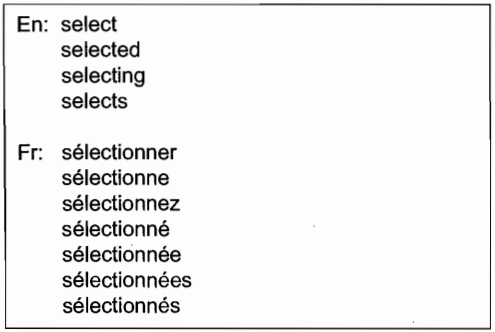Of course when terminology is inserted into the target text from the TMS, some editing may be required (e.g., to conjugate a verb), and this has raised an interesting question regarding which form of a term should be recorded on a term file. Traditionally, term files have always contained the canonical form of a term (the singular form of a noun,
the infinitive form of a verb, the masculine form of an adjective) . However, Kenny has observed that in order to reduce the amount of time spent editing terms that have been inserted directly from TMSs, some translators are now choosing to record the most common form of a term, or indeed several forms of a term, in the term record, as shown in figure 1. This way, the correct form can be inserted simply by clicking on it, and there will be no need to edit the term in the target text.
4. Shareability of information: networking, file formats, and standards
Terminology-management systems can be used as stand-alone tools, but more and more, they are being networked so that several users can access and contribute to the term base. In such cases, it may be desirable to give different users different types of privileges on the network system.

Figure 1 A sample term record in which multiple forms of the term have been recorded.
For instance, all users should be able to consult the information stored in the term base, but only some users, such as translators responsible for quality control, should be able to add new records.
Another way of sharing terminological information is by exchanging data with clients or with other translators. Unfortunately, not everyone uses the same TMS. Different applications store information in different formats, so in order to exchange information the file formats must be either compatible or convertible. Some TMSs will allow data to be exported directly to various word-processor or desktop-publishing formats or to be imported and exported according to international standards, such as the Machine-Readable Terminology Interchange Format (MARTIF – ISO 12200). A new standard, known as Term Base eXchange (TBX), is currently under development by the Open Standards for Container/Content Allowing Reuse (OSCAR) special-interest group belonging to the Localization Industry Standards Association (LISA).
5. Character sets and language-related difficulties
A limitation of some TMSs is the character sets that can be handled. Many computer applications, including some TMSs, have been written in such a way that they can only process single-byte characters. Therefore, translators who work with languages that require double-byte character sets (e.g., Chinese, Japanese, Korean) may not be able to use certain TMSs. This problem is now being addressed by numerous developers, who are seeking to incorporate double-byte encoding into future products and releases by adopting the Unicode Standard.
6. Economic aspects
Most translators will not find the cost involved in acquiring and maintaining a TMS to be prohibitive. Many systems are reasonably priced and can run on basic desktop computers that have limited memory and processing power. The amount of storage space required will depend on the size of the term base(s). However, if a translator wishes to run the TMS as part of an integrated suite with a translation memory system, the system requirements and price will go up.
责任编辑:admin
上一篇:Introduction of Text-Typologies
下一篇:Introduction of Term Extraction

微信公众号搜索“译员”关注我们,每天为您推送翻译理论和技巧,外语学习及翻译招聘信息。